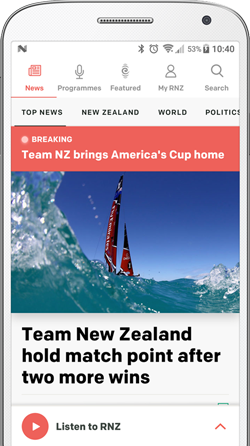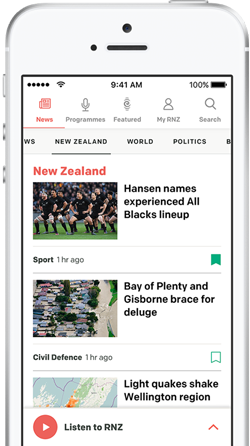
Hiroki Sakai of Auckland FC celebrates a goal by Neyder Moreno of Auckland FC. Photo: Andrew Cornaga/www.photosport.nz
A salary cap in sport is designed to be an equaliser but, in reality, not everything is equal.
The proposed changes to the A-League salary cap are not being met with unanimous approval.
From next season the Australia Professional League (APL), who run the A-League, want to set spending limits and reduce the number of players who sit outside the salary cap in a change that executive chair Stephen Conroy said would "ensure a competitive balance and to build long term foundations for growth that helps unlock the full revenue potential of each club".
However, Professional Footballers Australia (PFA), who represent the players, "do not believe the APL is on the right track".
"The changes as described would limit the ability of leading clubs to attract and retain top talen," new PFA chief executive Beau Busch said.
"They would weaken the product during a broadcast renegotiation and at a time when the league is desperate to attract fans."
Next season a $A3.5m hard cap trial would be put in place, followed in season 2026/27 by a hard cap of $A3m, plus one marquee player whose salary sits outside the cap.
Unlike the NRL, which picks up the wage bill for the Warriors and covers the entire salary cap for all of the rugby league clubs, the A-League clubs are in a different position.
This season the APL handed out funding of $A530,000 to each club, a significant reduction on previous seasons.
A-League clubs were required to spend a minimum of four times that amount on their playing squad. Meaning club owners were left to make up the difference.
This season the salary cap started at $A2.25 million and went up to a maximum of $A2.6 million.
However, currently clubs with owners with deep pockets and the desire to spend on luring top talent to the team can spend up to millions of dollars more beyond the salary cap by taking advantage of several exemptions. Which is something Wellington Phoenix general manager David Dome said the league's newest club, Auckland FC, were doing.
"They've used their millions to lure Alex Paulsen away from us and I'm sure it'll just be the start, but it takes more than money to be successful," Dome said in October of the former Phoenix goalkeeper who is now playing in his hometown on loan from English Premier League side Bournemouth.

Auckland FC's Alexander Paulsen up against Wellington Phoenix's Isaac Hughes, A-League Men, Round 7 on 7 December. Photo: Photosport / Shane Wenzlick
Under the current rules expansion clubs, like Auckland FC, have been allowed to spend more than the cap for two seasons.
This concession was to make up for the salary cap exemptions that new clubs could not take advantage of that were based on the length of time the club has been in the league (loyalty player) or an existing academy (homegrown player).
In total this season, and since the 2022/23 season when changes were made to the exemptions, there have been six different categories that allowed clubs to have players outside the salary cap.
Each club must sign between 18 and 23 players each season. This included two goalkeepers and up to five foreign (visa) players.
Clubs could have two marquee players on their books who were fully exempt from the salary cap; two designated players who earned between A300,000 to $A600,000 each but were not counted in the salary cap; a guest player who sat outside the salary cap but could only play for about half the season and met other eligibility criteria; up to four homegrown players who were fully exempt from the salary cap if they were aged under-23 and had come through the club's youth programme; an unlimted number of loyalty players that had played 10 or more consecutive seasons at the club in order for up to 50 percent of their salary to be put outside of the cap; and up to 16 scholarship players that sit outside the salary cap.
These concessional categories would be removed under the new salary cap plans.
Auckland FC director of football Terry McFlynn had been involved with the A-League since its inception 20 years ago and said he was "in favour of a salary cap."
"It's probably a good thing for the neutral and then obviously as a club you just got to make sure you can manage the cap accordingly and get the players that you want to get in under cap and maintain that winning mentality and maintain that performance within the salary cap environment," McFlynn said.
McFlynn acknowledged that clubs like Auckland and Melbourne City that are part of multi-club ownership groups, with interests in overseas leagues, have "the advantages of resources and finances" and that could be a "downfall" of a salary cap.
This season the Wellington Phoenix said they spent 97 percent of the salary cap and Auckland FC said they had used "probably all of the salary cap what's applicable to us this season".
"The salary cap runs on a three year cycle where what you don't spend one year or the second year, you can bank it and roll it over for the third year. So we've tried to obviously maximise the salary cap as much as you possibly can," McFlynn said of the existing arrangement.
Auckland FC are believed to have spent nearly twice as much as the Wellington Phoenix on their squad.
No one wants to talk exact numbers, as individual player's salaries are not made publicly available, but the A-League does currently allow for some players to make significantly more than others.

Photo: Shane Wenzlick / www.photosport.nz
Last season total player payments across the 12-team A-League - prior to Auckland's arrival - was $A57.8 million according to PFA.
The APL said this season each club was spending $A3 million on players.
"The current spending structure, which has been in place since 2005, was no longer fit for purpose," Conroy said.
Which players fell inside or outside of the salary cap this season was not something clubs publicised.
However, Phoenix captain Alex Rufer who first joined the club in the 2013/14 season would be considered a loyalty player.
The injured midfielder, import Francisco Geraldes, who joined the Phoenix part way through the season in February could have been a guest player.
For Auckland FC Luis Toomey, Liam Gillion and Finn McKenlay were among the players that are on scholarship contracts.
Negotiations
The Collective Bargaining Agreement is up for negotiation at the end of 2026 and could impact how much funding the APL allocated to clubs.
Hence the PFA's surprise at the APL announcing changes to the salary cap.
"Simply put, the APL are unable to unilaterally impose these conditions on the players without their agreement, which has certainly not been provided," Busch said.
"[The] announcement is simply the APL negotiating with themselves. As always, the employment conditions of players will be the product of proper, good faith bargaining; not unilateral decision making."
The PFA said in their report of the 2023/24 season: "The current salary cap framework has been imbued with a suite of exemptions to allow clubs to pursue a variety of different list strategies, from a youth focus to fan-pleasers to top end quality. The added flexibility has also prevented clubs from being cornered into disruptive and harmful rates of player turnover".
McFlynn was aware of the PFA's hopes for the future.
"I know the PFA are pushing hard for a higher level of distribution from the APL, higher level of salary cap and the floor of the cap to be raised as well in terms of player payments," McFlynn said.
"So I think if we can get a significant uplift in the broadcast deal, then it's going to be beneficial for the game and for the players as a whole."

Danny Vukovic (centre) and Mariners teammtes celebrate winning the A-League Men Grand Final 2024. Photo: PHOTOSPORT
Just before this season kicked off Wellington Phoenix coach Giancarlo Italiano said the salary cap allowed most teams to be capable of success in the A-League.
"We saw [Central Coast] Mariners last year, very similar to us, they ended up winning the league with a small budget, a lot of young players, a good coaching staff and some good ideas.
"That just shows that the league is very very close and I think if you have a bad day in the league you'll get punished and I think that's very good, very healthy," he said.
Who is contracted for the 2025/26 season?
League-leaders Auckland FC built their squad from scratch this season and McFlynn said the "main focus was to build a team from the community, for the community, and a team that's going to make the people of Auckland proud".
"For us to be sitting top of the league, four points clear with three games to go. I think our squad speaks for itself."
Most of the Auckland FC squad are locked in for another season.
All Whites goalkeeper Paulsen will end his loan stint at Auckland and will go back to Bournemouth, McFlynn said, and New Zealander Luis Toomey and Colombian Neyder Moreno are the other two players not confirmed for next season.
Auckland FC: Michael Woud, Joseph Knowles, Hiroki Sakai, Scott Galloway, Nando Pijnaker, Tommy Smith, Francis de Vries, Callan Elliot, Dan Hall, Louis Verstraete, Cameron Howieson, Adama Coulibaly, Finn McKenlay, Oliver Middleton, Jake Brimmer, Felipe Gallegos, Max Mata, Guillermo May, Marlee Francois, Liam Gillion, Jesse Randall, Logan Rogerson, Jonty Bidois.

Marco Rojas of the Phoenix during the A-League match against Macarthur FC at Sky Stadium in Wellington on 14 December 2024. Photo: Masanori Udagawa
The Phoenix let Marco Rojas go early from his contract and All White Kosta Barbarouses was also not on contract. Scott Wootton, Sam Sutton, Corban Piper, Stefan Colakovski and Dublin Boon were other players whose futures may or may not be with the Wellington club.
Wellington Phoenix:Josh Oluwayemi, Fin Roa Conchie, Tim Payne, Paulo Retre, Hideki Ishige, Alex Rufer, Isaac Hughes, Gabriel Sloane-Rodrigues, Lukas Kelly-Heald, Luke Supyk, Kazuki Nagasawa, Matt Sheridan, Luke Brooke-Smith, Alby Kelly-Heald, Xuan Loke, Jayden Smith and Nathan Walker.
Sign up for Ngā Pitopito Kōrero, a daily newsletter curated by our editors and delivered straight to your inbox every weekday.







